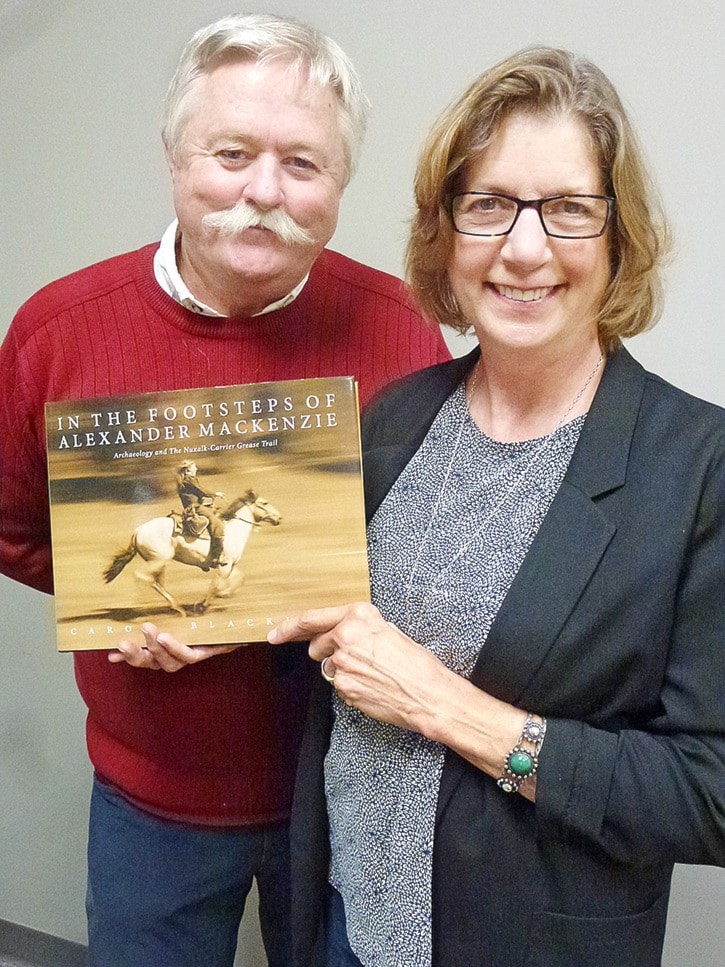It's a lingering irony that a well-used ancient First Nations trade route is remembered today – if it is remembered at all – by the name of a Scotland-born explorer.
Mention the Nuxalk-Carrier Grease Trail to most people and you're likely to get a blank look, even from those who pride themselves on knowing something about Canadian history.
But mention the journey of Alexander Mackenzie, who used the 450-km route from the Blackwater River (a tributary of the Fraser near Quesnel) to Bella Coola on the Pacific Coast, and you may get a flicker of recognition.
That journey – concluded on July 20, 1793 – was the significant final step in the first documented crossing of the North American continent "by a white man", predating the expedition of U.S. explorers Lewis and Clark by 11 years.
In a further irony – as White Rock author Carol Blacklaws points out – Mackenzie's American counterparts have a heritage trail and no less than 11 interpretive centres in their name, while Mackenzie's route languishes in obscurity increasingly encroached on by external development.
"It's not even recognized as a park corridor in Canada," she said. "We tend not to celebrate our own accomplishments."
But the Grease Trail (named for the grease of the eulachon fish – an important trading item among First Nations people many years before white explorers arrived) begins to get its due in Blacklaws' moving memoir, In The Footsteps of Alexander Mackenzie (Image West, Vancouver), which includes copious historical notes by her husband, Rick, an archaeology teacher at Langara College.
Blacklaws, a former, Social Studies, English and Spanish teacher and educational curriculum developer, launched the book Oct. 8 at South Surrey Recreation and Arts Centre's Turnbull Gallery.
The title of her book may seem to reinforce the irony of the trail's identification, but it is actually very truthful.
As a 25-year-old SFU grad employed as an archaelogical field assistant by the B.C. Government in 1979, Blacklaws literally and figuratively followed in Alexander Mackenzie's footsteps while surveying the trail.
Like him, she was an outsider. Like him, she learned not only a route but also discovered much to admire about the Native Lhoosk'uz Dene people, whose origins in the area go back some 4,000 years.
It is in no way a denigration of the accomplishment of Mackenzie, second-in-command Alexander McKay and their six French-Canadian voyageurs and two native guides, to note that perhaps their wisest decision was to heed the advice of Dakelh First Nations people not to continue down the Fraser, but to follow a westward overland route to the coast.
And that journey, documented in detail in his journals, is the story of daily – and with no little credit to Mackenzie – peaceful encounters with hospitable coastal First Nations peoples who had long used a vast trail system to link their communities and were already well-acquainted with non-natives and their trade goods.
As Blacklaws and her supervisor on the project – soon to become her partner in life – retraced Mackenzie's trip, identifying hundreds of archaelogical sites, they marvelled at an environment and a way of life still, at that time, little changed from his day.
"We followed his journal," Rick said. "His trail could be located from his descriptions of the landscape."
"What blew me away was that you'd read the book and see the same fish camps – 4,000 years of continuous occupation," Blacklaws said.
While Rick's notes in the book fill in the historical facts (he is a much published author himself), his sensitive photographs of the people and Blacklaws' personal narrative of her days working on the project supply a very human perspective.
"The story is about the trail and the archaeology and the history, but it's most especially about the people who live along the trail," said Blacklaws, who dedicated the book in part to the women of the Cariboo "who were tough enough to live the life, yet soft enough to open their hearts."
"I wanted to tell it as a memoir, through the eyes of an archaeological assistant," she said, adding that writing that way allowed her to offer first-hand observations and memories, without presuming to speak for First Nations peoples.
But the book has an added dimension – it's also succeeds as a coming-of-age tale of a young and still uncertain woman who found her feet travelling by wagon and even driving horses overland in a country that writer Paul St. Pierre has described as "good for men and dogs, but hard on women and horses."
In the process, she discovered that the man she was working with was the man she also wanted to spend the rest of her life with – and you don't get a much more romantic historical tome than that.
"I like my story," Blacklaws admits, adding that writing it allowed her to relive the experiences of her younger self.
But she's also pleased to have been able to turn her experiences along the Grease Trail into a book she hopes will inspire young Canadians to discover their own capabilities by exploring the land.
"I also wrote it to be proud of Canada's heritage," Blacklaws said. "This is a story people need to hear because it's so Canadian."
